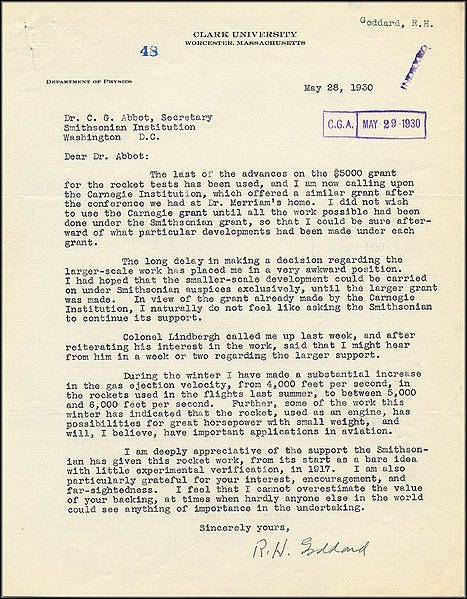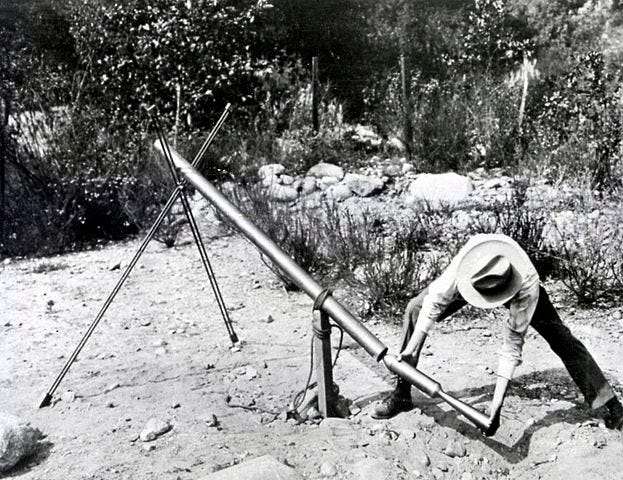The story of world's first liquid-fueled rocket
It wasn't easy…
A gift for all of you readers — Beautiful Space & Rocket-themed phone wallpapers
Now back to today’s article—
“It is difficult to say what is impossible, for the dream of yesterday is the hope of today and the reality of tomorrow.”
Robert H. Goddard
Dr. Robert Hutchings Goddard (1882-1945) is considered the father of modern rocket propulsion. Goddard was born in Worcester, Massachusetts, on October 5, 1882. He was often ill as a child and had extended absences from school. He attended college at the Worcester Polytechnic Institute where he received his BS in 1908. From there, he went on to Clark University where he earned his doctorate, taught physics, and began his experimentation with rockets.
Goddard successfully designed and launched his rocket using liquid fuel on March 16, 1926. The flight is considered as significant to the history as that of the Wright brothers at Kitty Hawk.
Struggle for funds
Primitive in their day as the achievement of the Wrights, Goddard’s rockets made little impression on government officials. Only through modest subsidies from the Smithsonian Institution and the Daniel Guggenheim Foundation, as well as the leaves of absence granted him by the Worcester Polytechnic Institute of Clark University, was Goddard able to sustain his lifetime of devoted research and testing.
Publicity and criticism
The sad thing is, many of his theories, inventions, and vision were commonly ridiculed by the media and other scientists. The basis of that criticism was the then-common belief that thrust was produced by the rocket exhaust pushing against the atmosphere; Goddard realized that Newton’s third law (reaction) was the actual principle and that thrust was possible in a vacuum.
In 1924, Goddard published an article, “How my speed rocket can propel itself in a vacuum”, in Popular Science, in which he explained the physics and gave details of the vacuum experiments he had performed to prove the theory. But, no matter how he tried to explain his results, he was not understood by the majority. After one of Goddard’s experiments in 1929, a local Worcester newspaper carried the mocking headline “Moon rocket misses the target by 238,799 1⁄2 miles.”
Persistence pays off
Earlier, in 1924–25, Goddard had problems developing a high-pressure piston pump to send fuel to the combustion chamber. He wanted to scale up the experiments, but his funding would not allow such growth. He decided to forego the pumps and use a pressurized fuel feed system applying pressure to the fuel tank from a tank of inert gas, a technique used today.
The liquid oxygen, some of which evaporated, provided its own pressure. On December 6, 1925, he tested the simpler pressure feed system. He conducted a static test on the firing stand at the Clark University physics laboratory. The engine successfully lifted its own weight in a 27-second test in the static rack. It was a major success for Goddard, proving that a liquid-fuel rocket was possible. After doing 3 more trial tests, he launched the world’s first liquid-fueled (gasoline and liquid oxygen) rocket on March 16, 1926, in Auburn, Massachusetts.
His diary entry, the next day after launch—
March 17, 1926. The first flight with a rocket using liquid propellants was made yesterday at Aunt Effie’s farm in Auburn. … Even though the release was pulled, the rocket did not rise at first, but the flame came out, and there was a steady roar. After a number of seconds it rose, slowly until it cleared the frame, and then at express train speed, curving over to the left, and striking the ice and snow, still going at a rapid rate.

He successfully pioneered modern methods such as two-axis control (gyroscopes and steerable thrust) to rockets to control their flight effectively. Two of Goddard’s 214 patented inventions, a multi-stage rocket (1914), and a liquid-fuel rocket (1914), were important milestones toward spaceflight.
“Every vision is a joke until the first man accomplishes it; once realized, it becomes commonplace.”
—Goddard’s response to a reporter’s question following criticism in The New York Times, 1920.
Though the unimaginative public chuckled at the “moon man,” his groundbreaking paper was read seriously by many rocketeers in America, Europe, and Russia who were stirred to build their own rockets. This work was his most important contribution to the quest to “aim for the stars.”
Don't you know about your own rocket pioneer? Dr. Goddard was ahead of us all.
–Wernher von Braun, when asked about his work, following World War II.






![Fun Fact: In 1920, the New York Times published an editorial claiming that Robert Goddard "lack[ed] the knowledge ladled out daily in high schools" and that it was "absurd" to believe that rockets would work in space. They issued a correction on July 17 ... Fun Fact: In 1920, the New York Times published an editorial claiming that Robert Goddard "lack[ed] the knowledge ladled out daily in high schools" and that it was "absurd" to believe that rockets would work in space. They issued a correction on July 17 ...](https://substackcdn.com/image/fetch/$s_!LrpD!,w_1456,c_limit,f_auto,q_auto:good,fl_progressive:steep/https%3A%2F%2Fsubstack-post-media.s3.amazonaws.com%2Fpublic%2Fimages%2Fc89b1d7c-3bc7-495e-869f-82d4d112a69a_1080x351.png)
